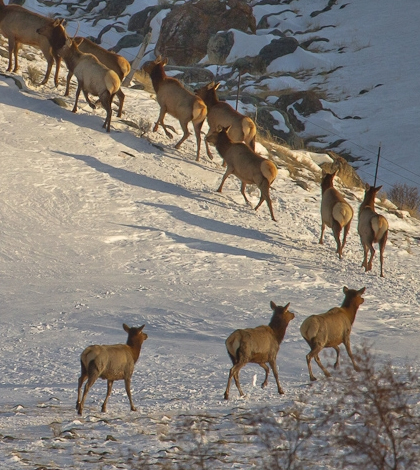Advanced GPS collars track yellowstone elk

Elk migrations simultaneously shape and are shaped by the greater Yellowstone ecosystem. (Credit: Jonny Armstrong / University of Wyoming)
Arthur Middleton has studied migrating populations since his grad school days, but he knows it doesn’t take a PhD to recognize why Wyoming attracts a certain kind of person. They’re nature-lovers, he says, outdoor enthusiasts who value unspoiled wilderness — and want to live next door to the ineffable Yellowstone National Park. But the yellowstone elk that roam Wyoming are a little harder to pin down.
That’s why Middleton, an ecologist at the Yale School of Forestry and Environmental Science, helped lead a study to map the migration patterns of nine major elk herds throughout Yellowstone and across the state. Using GPS technology, Middleton and University of Wyoming researchers collared and tracked elk to determine how their movements impact the surrounding ecosystem.
“We’ve known about Yellowstone and these animals for 130 years or so, but only in the past decade and a half have we been able to actually map their seasonal migrations,” Middleton said.
This capability is largely permitted by technological trends toward miniaturization. In the past, Middleton says, limited battery life prevented GPS collars from measuring more than one location per day. Without built-in telemetry, data could only be collected from the collars by physical retrieval once the collar fell off the animal.
The collars used in Middleton’s study mark an elk’s location once every half an hour, and transmit those data via satellite for near real-time monitoring. These advancements allow for “very, very, very detailed” migration tracking, Middleton says. When combined with historical migration information from previous research, the data paint a more comprehensive picture of how these herds’ movements fit into the larger ecosystem in and around Yellowstone.

Researchers collared and tracked nine major elk herds throughout Yellowstone and Wyoming. (Credit: Jonny Armstrong / Wyoming Cooperative Wildlife Research Unit/University of Wyoming)
“That ability to migrate is what makes them abundant,” Middleton said. “And their abundance is what sustains the big predators and the hunting economy outside of the park.”
Middleton helped collar three of the nine major herds tracked in the study. The process was simple enough: Researchers meet in the morning with a game warden and helicopter pilot to establish the day’s itinerary. Once a capture point is picked, Middleton helps guide the helicopter and its crew to the location. With a target in sight, a crewmember uses a net gun to immobilize it, while another jumps out and hobbles the animal before collaring it. The collared elk is then released, and the crew heads to the next capture point. The whole process happens quickly, and on a good day the crew can capture an elk every 20 or 30 minutes.
Occasionally, capture points were set on or near private land, making capture and collaring a little tricker, Middleton said.
“We need to be careful about where and how we capture animals,” he said. “We don’t want to knock down fences, or cause any undue stir.”
It took no more than a couple of days to collar a sample for a given population. Due to the elk’s migratory habits, it isn’t uncommon to lose a collared individual or two to a hunter if the herd strays from the park’s boundaries, but Middleton says he and the other researchers see this as a routine part of the job rather than a complication.
The elk migration tracking study is part of a larger project conducted by UW, the Wyoming Game and Fish Department and the U.S. Geological Survey. In addition to elk, the project examines population movements among moose, bighorn sheep and mule deer. Public outreach is a big goal of the project, and while some scientists are turning to social media to accomplish that, Middleton is focused on creating a traveling museum exhibit and short film about the elk’s migrations. He sees “both a need and opportunity to connect with people” to better inform them about the role these populations play in the park’s overall health.
While it’s still far too soon to draw meaningful conclusions from the ongoing tracking project, Middleton says the studies it comprises should help answer some vital questions about the park and the animals that live there: What species sustain the Yellowstone ecosystem? Where do they go? And what ecological and landscape changes are shaping them and their migrations into the future?
“The big thrust of the project is kind of rethinking the Yellowstone as a migratory landscape,” he said. “It’s about the creatures that make the landscape tick.”
Top image: Elk migrations simultaneously shape and are shaped by the greater Yellowstone ecosystem. (Credit: Jonny Armstrong / Wyoming Cooperative Wildlife Research Unit/University of Wyoming)




Alfred Bruckner
September 10, 2022 at 7:35 pm
Is there a site where I can go to find out about a specific elk? I saw an elk with #42 on the collar.
Thank you in advance